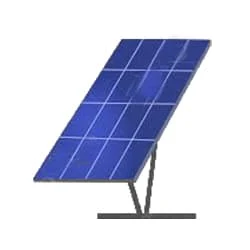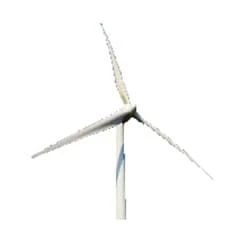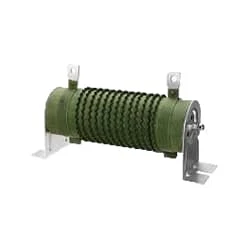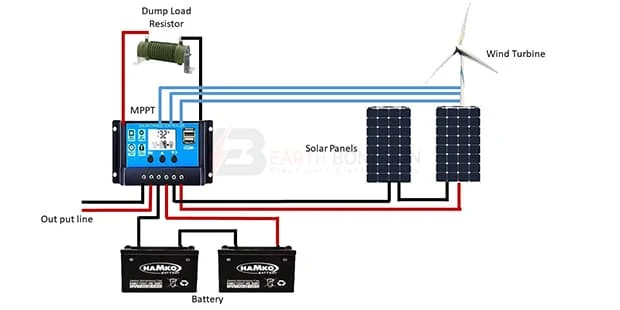Solar Wind Hybrid Energy System Diagram:
This Diagram Shows Wind Solar is Used For Generating Power Called a Wind-Solar Hybrid System. This System is Designed Using Solar Panels and Small Wind Turbine Generators for Generating Electricity. Solar and Wind Hybrid Power Systems are Designed Using Solar Panels and Small Wind Turbine Generators for Generating Electricity.
Diagram of Solar Wind Hybrid Energy System Diagram:
Components Need for this Project:
You can get the components from any of the sites below:
- Solar Panel [See Buy Click Amazon]
- MPPT [See Buy Click Amazon]
- Wind Turbine [See Buy Click Amazon]
- 12V Battery [See Buy Click Amazon]
- Dump Load Resistor [See Buy Click Amazon]
*Please note: These are affiliate links. I may make a commission if you buy the components through these links. I would appreciate your support in this way!
Read Also:
Components used to make the Solar Wind Hybrid Energy System Diagram:
01. Solar Panel
 |
| Fig 2: Solar Panel |
Photovoltaic solar panels can generate electricity directly from sunlight. Photovoltaic (PV) modules are connected assemblies of photovoltaic solar cells available in a package of various voltages and wattages, but not direct sunlight. And the sun also does not transmit electricity directly to the earth. Sends light and heat. It has to convert our electricity in different ways. We get heat energy from the sun very easily. Instead, it transmits light and heat.
02. MPPT
 |
| Fig 3: MPPT |
The function of a solar charge controller is to charge the battery by regulating the voltage and current coming from the solar. That is, reduce the voltage slightly so that the battery cell is not damaged due to high voltage. It's called a controller rather than a charger because it's so smart. Automatically provides proper power to the battery according to over voltage, over the current, short circuit, and battery temperature. There are two types of charge controllers. PWM and MPPT, PWM is relatively cheaper but has lower efficiency. On the other hand, good quality MPPTs are very efficient and offer maximum safety to the battery.
03. Wind Turbine
 |
| Fig 4: Wind Turbine |
Wind Turbines can Turn The Power of The Wind Into The Electricity we all Use to Power Our Homes and Businesses. Each of These Turbines Consists of a Set of Blades, a Box Beside Them Called a Nacelle, and a Shaft. The Wind Even Just a Gentle Breeze Makes The Blades Spin Creating Kinetic Energy. The Blades Rotate in This Way And Then Also Make The Shaft in The Nacelle Turn And a Generator in The Nacelle Converts This Kinetic Energy Into Electrical Energy.
04. 12V Battery
 |
| Fig 5: 12V Battery |
A 12-volt Battery is an Irregular Battery used in Specific Electronic Applications. Of all the types of Batteries, the 12-Volt Battery is one That Looks Very Different Depending on its use. It can be Large or small, Heavy or Light. Twelve-volt batteries are commonly used in RV, Boat, and Other Automobiles Systems. From a Technical Perspective, a Battery Uses one or more cells to Allow a Chemical Reaction Creating the flow of Electrons in a Circuit.
05. Dump Load Resistor
 |
| Fig 6: Dump Load Resistor |
This diverts load resistor is for use to divert the excess power Being Generated When wind Turbine Generator Batteries are full and can be run at 100% duty cycle due to the quality Double wire wound Design. It Can Also be Used With a Solar Array. A dump load for a Wind resistor is a device or system that is used to dissipate excess Energy generated by the turbine when the power Grid is not able to Accept it. The Function of a Resistor is to Block an Electric Current.
Thank You for visiting the website. Keep visiting for more Updates


Post a Comment
Do leave your comments